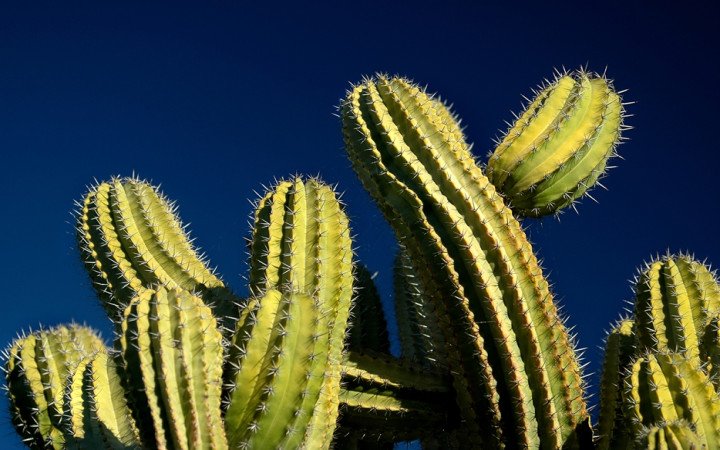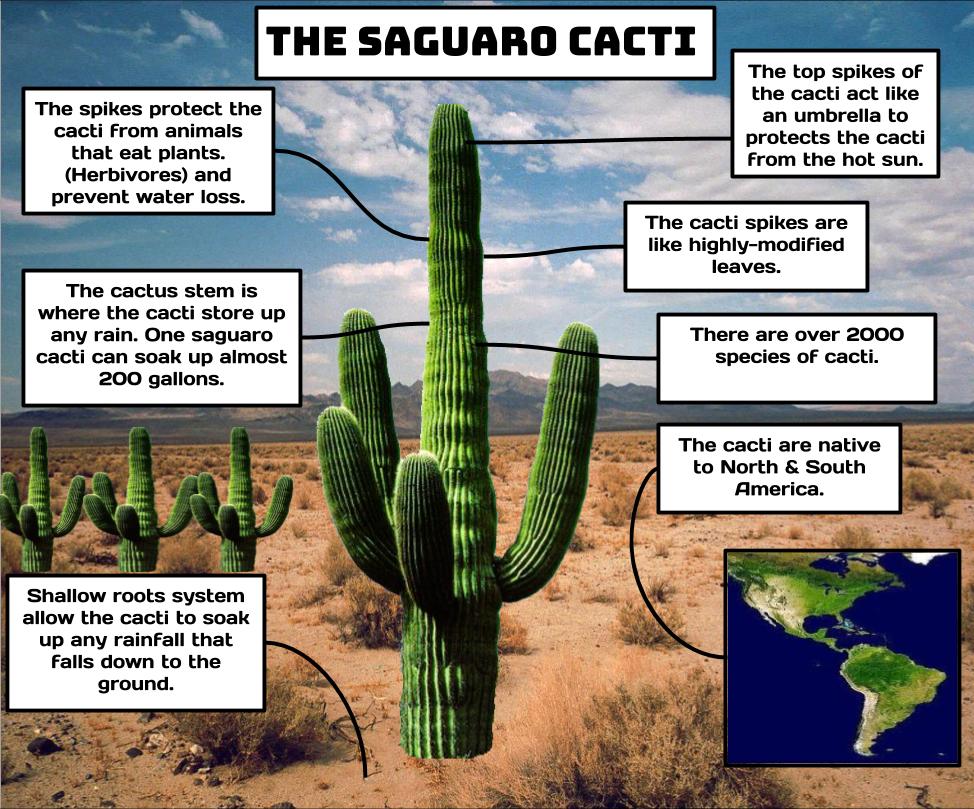How Does A Cactus Live Without Water

In the hot, dry desert, cacti are masters at surviving without water. They have many adaptations that allow them to live in arid conditions and even thrive. One of the most important adaptations is their thick, fleshy leaves which store water.
The waxy coating on their leaves helps to prevent evaporation, and their spines also help by providing shade. Cacti are able to absorb moisture from the air through their pores, and they can even extract water from the fog that settles on them at night.
Cactus | Cactus Lives Without Water | Interesting Facts About Plants
It’s a common question – how does a cactus live without water? The answer is actually pretty simple. Cacti are succulents, meaning they store water in their leaves and stems.
This means that they can go long periods of time without watering, making them ideal for dry climates or for people who forget to water their plants! When it does rain, cacti are able to absorb a lot of water quickly, which helps them survive during drought conditions.
How Long Can Indoor Cactus Live Without Water
Most cacti are native to dry, arid regions and can survive long periods without water. However, when grown as houseplants, they will need regular watering to stay healthy. How often you need to water your cactus will depend on the type of plant, the size of the pot, and the climate where you live.
In general, indoor cacti should be watered about once a week during the growing season (spring and summer), and every other week during the dormant season (fall and winter).
If you’re not sure whether your cactus needs water, it’s best to err on the side of caution and give it a drink. When in doubt, check the soil before watering.
If it’s dry several inches below the surface, it’s time to water. Be sure to empty any water that collects in the saucer beneath the pot after watering so that your plant doesn’t sit in soggy soil.
It’s possible for indoor cacti to survive without being watered for months at a time, but they will start to look unhealthy if they go too long without moisture.
If your plant starts to shrivel or its leaves begin to drop off, give it a good soaking and then resume a more regular watering schedule. With proper care, most indoor cacti will thrive for years.
How Long Can Cactus Live Without Soil
Cacti are some of the most drought-tolerant plants in the world. They can store water in their stems and roots, which helps them survive for long periods without rainfall. But how long can a cactus live without soil?
The answer depends on the type of cactus. Some species can survive for weeks or months without any soil at all. Others will begin to wilt after a few days without water.
And still others will only last a few hours before they start to shrivel up and die.
So, if you’re thinking about growing cacti without any soil, it’s important to choose a species that is known to be tolerant of such conditions. And even then, it’s best to keep them well-watered during prolonged periods of drought.
How Much Water Does a Cactus Need
Cacti are often thought of as plants that don’t need much water. And while it’s true that they can survive in arid conditions, they still need some water to stay healthy. How much water a cactus needs depends on the type of cactus, the climate it’s growing in, and the time of year.
In general, cacti grown in hot, dry climates will need less water than those grown in cooler, more humid climates. And during the active growth season (usually spring and summer), cacti will need more water than during the dormant season (fall and winter).
So how much water does a cactus need?
It depends, but a good rule of thumb is to give your cactus about an inch of water per week during the active growth season. Be sure to allow the soil to dry out completely between watering so that you don’t risk overwatering. If you’re not sure whether your cactus needs water or not, it’s always better to err on the side of caution and wait another day or two before watering again.
How Long Can a Small Cactus Go Without Water
If you’re wondering how long a small cactus can go without water, the answer is that it depends on the type of cactus. Some cacti are more drought-tolerant than others, so they can survive for longer periods of time without water. However, all cacti need some water to survive, so it’s important to give them a good watering every once in awhile.
How Long Can a Saguaro Cactus Live Without Water
Saguaro cacti are one of the most iconic plants of the American Southwest. These stately cacti can grow to be over 60 feet tall and live for hundreds of years. So, how long can a saguaro cactus live without water?
While saguaros are adapted to survive in arid conditions, they do need some water to survive. A mature saguaro can store enough water to last it for up to two years! However, during extended drought conditions, even a well-hydrated saguaro will start to show signs of stress.
Saguaros that are stressed from lack of water will often stop growing and produce fewer flowers and fruits.
If you live in an area where drought is common, it’s important to give your saguaros a little extra water during the dry months. While they may not look like they need it, a deep watering once every few weeks will help them stay healthy and happy for many years to come!

Credit: twitter.com
How Does a Cactus Survive in the Desert With No Water?
In order to survive in the desert, cacti have evolved a number of special adaptations. One is their thick, waxy skin, which helps them to retain water. They also have shallow roots that spread out wide, rather than deep roots that go down into the ground.
This allows them to capture rainwater when it does fall, and prevents the water from quickly evaporating. Some cacti also have spines, which help to shade the plant and reduce evaporation.
Cacti are able to store large amounts of water in their stem tissue.
When it rains, they quickly absorb as much water as possible and expand to several times their normal size. This reserve of water can sustain them for months or even years at a time without any additional rainfalls.
To further prevent evaporation, cacti open their pores (stomata) only at night when the air is cooler and more humid.
During the day, they close their pores to conserve moisture.
Despite these adaptations, life in the desert is still difficult for cacti and they grow very slowly. Some species of cactus may live for hundreds or even thousands of years though!
How Does Cactus Survive Without?
Cacti are some of the most interesting plants in existence. They have adapted to survive in conditions that would kill most other plants. One of the ways they have done this is by developing a special type of photosynthesis that allows them to thrive in arid environments.
Most plants rely on something called C3 photosynthesis. This process uses sunlight to convert carbon dioxide from the air into glucose, which the plant uses for energy. However, this process is not very efficient in hot, dry conditions like those found in deserts.
Cacti have evolved a different type of photosynthesis, called CAM (crassulacean acid metabolism). In CAM photosynthesis, the cactus opens its stomata at night when it is cooler and takes in carbon dioxide. It then stores the carbon dioxide as malic acid until daylight comes again and it can close its stomata.
When sunlight hits the stored malic acid, it breaks down and releases the carbon dioxide so that it can be used for C3 photosynthesis. This process helps cacti minimize water loss during the day when evaporation is at its highest.
In addition to their unique form ofphotosynthesis, cacti also have thick skin and fleshy leaves that help them store water.
Some species even have spines that protect them from being eaten by animals and help reflect heat away from their bodies. All of these adaptations allow cacti to survive without much water – sometimes getting by on just a few inches per year!
How Can Cactus Plants Live Where It is So Dry?
Cactus plants have evolved to be able to survive in dry conditions by developing a number of adaptations. One key adaptation is the ability to store water in their stems and leaves, which helps them to survive long periods without rainfall. They also have a waxy coating on their leaves which helps to prevent water loss, and they often grow in rocky or sandy soils which have good drainage.
Their shallow roots also help them to obtain water from even the driest soils.
Can A Cactus Survive Without Sunlight If It Doesn’t Get Water?
Can a cactus survive without sunlight if it doesn’t get water? cactus survival tips indicate that while cacti can tolerate drought, they still need some sunlight to carry out photosynthesis. Without sunlight, their growth rate may decrease, and they might become weak and pale. However, some species can survive for short periods in low-light conditions, relying on stored water and nutrients. It’s crucial to strike a balance, offering adequate but not excessive light and water to ensure successful cactus survival.
Why Can a Cactus Survive in a Place With Little Water?
A cactus can survive in a place with little water because it is adapted to living in dry conditions. It has developed special features that allow it to store water and make the most of the moisture that is available. The cactus has a thick, waxy skin that helps to prevent water loss, and its leaves are small and close to the stem to reduce evaporation.
Underneath the ground, the cactus has a large root system that absorbs any moisture that is present. All of these adaptations enable the cactus to live in an environment where water is scarce.
Conclusion
In the desert, cacti are some of the most interesting and unique plants. They have adapted to survive in an environment where water is scarce. Cacti store water in their fleshy leaves and stems.
They also have shallow roots that spread wide to collect as much water as possible when it does rain. In addition, cacti have a waxy coating on their leaves that helps prevent evaporation.